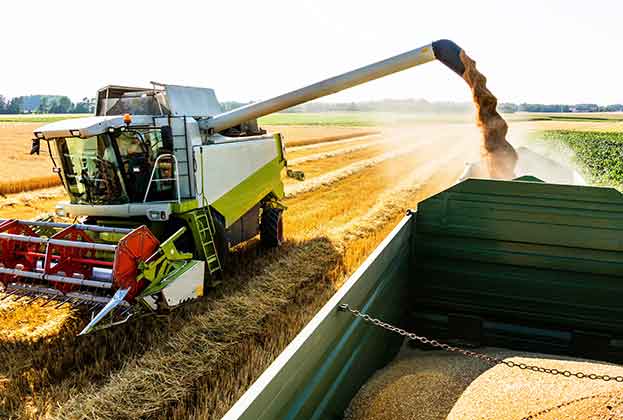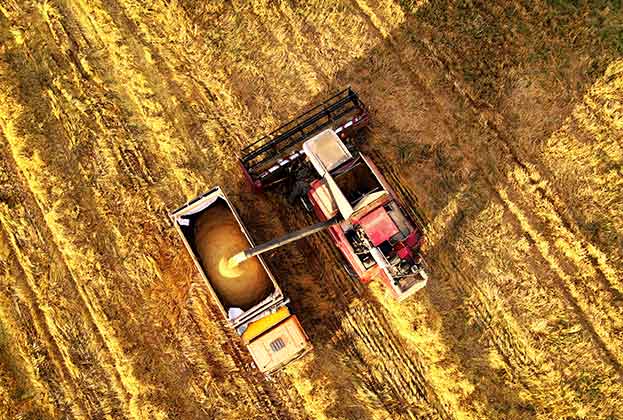The US dynamic farmland market offers a strong correlation between values and prices
The US is a large and dynamic farmland market and has unparalleled availability of market data. With a strong correlation between capital values, rents, earnings and commodity prices, it is a near-perfect market environment. Long known for its appeal among US institutional and private investors, the prospects for overseas investors look strong.

Farm structures
There are about 364 million hectares of “land in farms”, made up of two million individual farms, with an average size of 182 hectares. About 60% of farmland is owner-occupied, with the remainder leased from non-farming owners, over a third of whom are retired farmers.
Institutional ownership levels, while some of the highest in the world, remain low at 2.2%, but are growing every year. Importantly, about 70% of farmland is set to change hands in the next 20 years, according to the US Department of Agriculture, and institutional investors are poised to gain a bigger share as farmers retire.
There has been a significant increase in the last three years of US farmland owned by overseas investors – up to 2.9% of all privately held US agricultural land (1.7% of all land in the US). Over the last ten years, overseas ownership of cropland increased from roughly 1.7 million to 4.4 million hectares. The vast majority of US cropland produces annual row crops and permanent cropland encompasses less than 1% of total US land area; however, the total investable permanent crop universe is estimated to be worth at least USD 71 billion.
Long known for its appeal among US institutional and private investors, the prospects for overseas investors look strong
Nicola Buckingham, Director, Rural Research
The regions that have attracted significant interest over the last ten years include the Corn Belt (annual row crops, principally corn and soybeans), the Pacific (permanent crops) and the Southeast/Delta (annual row crops and horticultural crops). Vineyards, apple and nut orchards and citrus groves are among the most popular perennials in the US. While 80% of permanent cropland is owner-operated, the remaining 20% is leased or custom farmed land owned by rural land investors.
Capital value trends
Savills Research shows that cropland prices appreciated by about 8% in 2021 after a number of years of more muted growth, to USD 10,920 per hectare. Pasture average value in 2021 was USD 3,650 per hectare and all farm real estate averaged USD 8,350 per hectare. Land values have risen for most of the last 120 years and saw only a few periods of decline – one being the agricultural depression of the 1930s and the other being the farm credit crisis of the 1980s.
REGIONAL SPOTLIGHT
- Corn Belt: This includes the states of Illinois, Indiana, Iowa, Missouri and Ohio. Illinois and Iowa have the most expensive land – cropland values have increased in Illinois by 8.2% to USD 19,520 per hectare and in Iowa by 8.9% to USD 19,300 per hectare. Values here are highly correlated to corn and soybean prices and have continued to grow in 2022.
- Southeast and Delta States: Average 2021 values in Florida of USD 18,040 per hectare are 65% higher than the US cropland average, highlighting the flexible soils suitable for horticultural operations in many parts of the state. Georgia is also a key state for horticultural and permanent crop opportunities with average values of USD 8,600 per hectare. Values are lower in Arkansas, Mississippi and Louisiana.
- Pacific: California has some of the most expensive land, with average cropland values of USD 34,250 per hectare in 2021; land with irrigation is more expensive at USD 40,260 per hectare. It is the ’home’ of large-scale permanent cropping. Average values in Washington State and Oregon are much lower, at USD 6,670 per hectare (USD 19,270 per hectare with irrigation) and USD 8,180 per hectare (USD 14,330 per hectare with irrigation), respectively.
OPERATING MODELS
As one of the most developed and institutionalised markets, the US offers the most flexible range of models for farmland investing:
- Cash-lease (fixed) Annual income is determined prior to the operating year and is not subject to fluctuations in crop yields/prices.
- Cash-lease (variable) Minimum base rent with income participation based on price and/or yield.
- Revenue share lease All income is determined based on revenue, or some other measure of crop profitability.
- Custom (contract) farming Annual income is determined solely by the profitability of the crop operation, but a third-party custom farmer is paid to undertake the operations.
- Full operational model Annual income is determined solely by the profitability of the crop operation with the local operating company/SPV undertaking the operations with its own staff and machinery.
Read the articles within Global Farmland Spotlight below.
.jpg)


